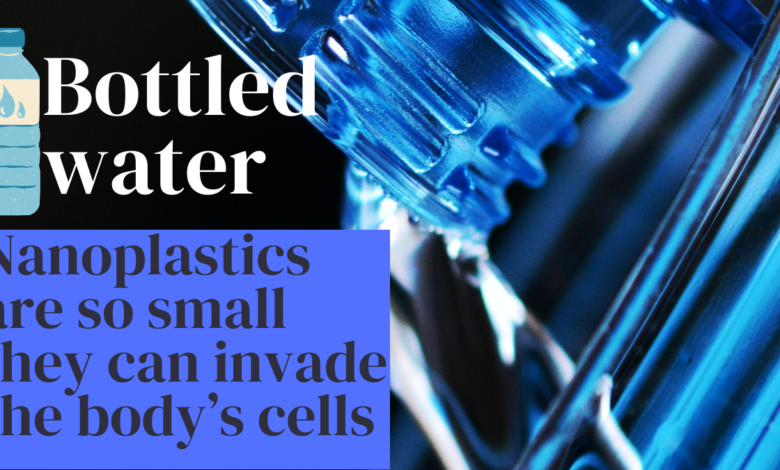
Researchers have made a ground-breaking discovery in a recent study, finding that bottled water sold in stores can contain 10 to 100 times more microscopic particles of plastic than previously thought. These nanoparticles are so minuscule that they cannot be detected under a microscope.
Measuring at 1,000th of the average width of a human hair, these nanoplastics are incredibly small and have the potential to travel through the tissues of the digestive tract or lungs and into the bloodstream. Experts warn that this could lead to the distribution of potentially harmful synthetic chemicals throughout the body and into cells.
The study revealed that one liter of water, equivalent to two standard-size bottled waters, contained an average of 240,000 plastic particles from seven different types of plastics. A staggering 90% of these particles were identified as nanoplastics, with the remainder being microplastics.
Microplastics consist of polymer fragments that can vary in size from less than 0.2 inches (5 millimeters) down to 1/25,000th of an inch (1 micrometer). Smaller particles are termed nanoplastics and must be measured in billionths of a meter.
Sherri “Sam” Mason, director of sustainability at Penn State Behrend in Erie, Pennsylvania, who was not involved in the study, expressed, I have to say, is exceedingly impressive. The body of work that they put into this was really quite profound. its groundbreaking.”
Mason emphasized that the new finding reinforces the long-standing expert advice to consume tap water from glass or stainless steel containers to minimize exposure. She further mentioned that this advice also applies to other foods and drinks packaged in plastic.
” “People may not consider plastics as shedding, but they do,” she pointed out. “In a manner similar to how our skin constantly sheds cells, plastics shed little bits that break off, for example, when opening a plastic container for a store-bought salad or unwrapping cheese encased in plastic.”
How many nanoplastics are there?
Mason, the coauthor of a 2018 study, detected the presence of micro- and nanoplastics in 93% of samples of bottled water from 11 different brands across nine countries.
In the previous study, Mason determined that each contaminated liter of water contained an average of 10 plastic particles wider than a human hair, and 300 smaller particles. However, five years ago, there was no method to analyze these tiny flecks or determine if there were more.
Mason clarified that it was not a matter of being unaware of the existence of nanoplastics, but rather a limitation in our ability to analyze them.
In a recent study published in the journal Proceedings of the National Academy of Sciences, researchers from Columbia University unveiled a new technology capable of observing, tallying, and scrutinizing the chemical makeup of nanoparticles present in bottled water.
Contrary to the previous estimate of 300 per liter, the team discovered that the actual quantity of plastic particles in three popular U.S. brands of bottled water ranged from 110,000 to 370,000, if not more. (The specific brands under study were not disclosed by the authors.)
Beizhan Yan, an associate research professor at Columbia University’s Lamont-Doherty Earth Observatory and coauthor of the study, stated that the new technology was capable of identifying millions of nanoparticles in the water, encompassing “inorganic nanoparticles, organic particles, and some other plastic particles not among the seven major plastic types studied.”
The study’s innovative techniques pave the way for further research to gain a better understanding of the potential risks to human health, as stated by Jane Houlihan, research director for Healthy Babies, Bright Futures, an alliance dedicated to reducing babies’ exposures to neurotoxic chemicals. Houlihan, who was not involved in the study, highlighted the significance of this advancement.
Houlihan stated in an email that there is a suggestion of widespread human exposures to minuscule plastic particles, which pose largely unstudied risks. Infants and young children, whose developing brains and bodies are often more vulnerable to impacts from toxic exposures, may face the greatest risks, according to the article on CNN.
Risks to Human Health
Nanoplastics are regarded as the most concerning form of plastic pollution for human health by experts. This is due to the ability of minuscule particles to infiltrate individual cells and tissues in major organs, potentially disrupting cellular processes and depositing endocrine-disrupting chemicals such as bisphenols, phthalates, flame retardants, per- and polyfluorinated substances, or PFAS, and heavy metals.
Mason explained that all of the chemicals used in manufacturing plastic are carried by the plastic itself, meaning that when plastic enters the body, it brings those chemicals along. Due to the body’s higher temperature, these chemicals are likely to migrate out of the plastic and into our bodies. Mason also noted that these chemicals can travel to the liver, kidneys, brain, and even cross the placental boundary to reach an unborn child.
Researchers discovered plastic chemicals in the brains, hearts, livers, kidneys, and lungs of developing baby mice within 24 hours of pregnant mothers ingesting or inhaling plastic particles, according to Phoebe Stapleton, coauthor of the study and associate professor of pharmacology and toxicology at Rutgers University’s Ernest Mario School of Pharmacy in Piscataway, New Jersey.
Stapleton noted, “Micro and nanoplastics have been detected in the human placenta, lung tissues, feces, and blood.” Additionally, while the potential harm from the chemicals and toxic metals in plastics has been studied, there is a lack of research on whether the plastic polymer itself is also detrimental to the body.
Mason emphasized the importance of understanding polymers, the essential component of plastics, as the new frontier in the field. With the development of a new approach, the potential impact of polymers on human health can now be comprehensively assessed, addressing a previous limitation in this area.
In response to the study’s findings, the International Bottled Water Association, representing the industry, emphasized the need for thorough scientific review and further research to establish standardized methods for measuring and quantifying nanoplastics in the environment.
Media reports about nano- and microplastic particles in drinking water only serve to needlessly alarm consumers, as there is currently no standardized methods or scientific consensus on the potential health impacts of these particles.
What types of plastic are you ingesting?
The study’s innovative approach to identifying nanoparticles in bottled water utilizes a modified form of Raman spectroscopy, a laser-based method that can assess the chemical makeup of particles by observing their vibrational response to light.
The adapted technique, known as stimulated Raman scattering microscopy (SRS), incorporates a second laser to “magnify the previous signal significantly, enabling the detection of previously unseen nanoparticles,” explained senior author Wei Min, a chemistry professor at Columbia University in New York City, who co-invented SRS in 2008.
Min mentioned, “This study is pioneering in its application of microscopy to the realm of nanoplastics.”
By significantly enhancing the imaging capabilities, SRS is able to swiftly and clearly detect and capture images of nanoparticles within microseconds, as opposed to the hours previously required by older techniques — all without causing harm to the tissues being examined.
“However, merely observing the particles isn’t sufficient, as it’s important to ascertain whether they are plastic or not. To address this, we have developed a novel machine learning technology that enables us to accurately identify and categorize the specific type of plastic,” Yan explained.
At the time of release, the study’s algorithm could detect seven kinds of plastics: polyamide, polypropylene, polyethylene, polymethyl methacrylate, polyvinyl chloride, polystyrene, and polyethylene terephthalate.
“We initially anticipated that most of the microplastics in bottled water would originate from the bottle itself, typically made of PET (polyethylene terephthalate) plastic,” explained lead author Naixin Qian, a doctoral student in chemistry at Columbia University.
“We discovered a variety of plastics in bottled water, “each with varying size distributions,” she observed. “While PET particles were larger, others were as small as 200 nanometers.”
Studies have shown that PET plastic particles can detach when the bottle cap is repeatedly opened and closed, the bottle is crushed, or when exposed to heat, such as in a car.
Much more research to undertake:
Now that nanoplastics can be identified and classified, there is vast potential for research to address numerous questions. For instance, if the nanoplastics present in bottled water did not originate from the bottle itself, where did they originate? The Columbia team is exploring the possibility that the remaining nanoplastics may have come from the source water, potentially affected by some aspect of the manufacturing process.
Another critical inquiry is: Which contains fewer nanoplastics and chemical residues, bottled or tap water?
Yan has indicated that multiple studies have shown decreased levels of microplastics in tap water. Therefore, it is reasonable to anticipate lower levels of nanoplastics in tap water as well, since they have common sources. “We are currently investigating this issue,” Yan added.
What occurs when the plastic polymer and endocrine-disrupting chemicals penetrate the body’s cells? Do they persist, causing disruption or damage to cellular processes, or does the body manage to expel them?
“We are aware that these microparticles are entering the body, with even higher percentages of smaller nanoparticles entering cells, but their exact locations within the cell and their activities remain unknown,” Stapleton noted. “Additionally, it is uncertain whether or how they are exiting the cells.”
Nevertheless, the new technology is suitable for examining human tissue samples and is expected to yield insights in the near future, according to Min.
Min stated that upon examining the raw data, it becomes evident that it consists of a sequence of images. Furthermore, ample data demonstrates that if a particle enters a specific location within a particular type of cell, then its precise spatial location can be determined.
According to Healthy Babies, Bright Futures’ Houlihan, while science delves into these inquiries and more, individuals can take steps to minimize their exposure to plastics. “We can refrain from consuming food and drinks from plastic containers, opt for garments crafted from natural fabrics, and choose consumer goods made from natural materials,” Houlihan suggested. ” By evaluating the use of plastic in our daily routines and finding substitutes whenever possible, we can have a meaningful impact.





